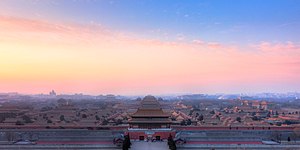 The Forbidden City viewed from Jingshan Hill The Forbidden City viewed from Jingshan Hill | |
  | |
| Established | 1406–1420 1925 (as public museum) |
|---|---|
| Location | 4 Jingshan Front St, Dongcheng District, Beijing, China |
| Coordinates | 39°54′57″N 116°23′27″E / 39.91583°N 116.39083°E / 39.91583; 116.39083 |
| Type |
|
| Visitors | 16.7 million |
| Curator | Wang Xudong |
| Website | dpm.org.cn (in Chinese) intl |
| Area | 72 hectares |
| Built | 1406–1420 (Ming dynasty) |
| Architect | Kuai Xiang |
| Architectural style(s) | Chinese architecture |
| UNESCO World Heritage Site | |
| Part of | Imperial Palaces of the Ming and Qing Dynasties in Beijing and Shenyang |
| Criteria | Cultural: i, ii, iii, iv |
| Reference | 439-001 |
| Inscription | 1987 (11th Session) |
| Forbidden City | |||||||||||||||||||||||||||||
|---|---|---|---|---|---|---|---|---|---|---|---|---|---|---|---|---|---|---|---|---|---|---|---|---|---|---|---|---|---|
 "Forbidden City" in Chinese characters "Forbidden City" in Chinese characters | |||||||||||||||||||||||||||||
| Chinese name | |||||||||||||||||||||||||||||
| Chinese | 紫禁城 | ||||||||||||||||||||||||||||
| Literal meaning | "Purple Forbidden City" | ||||||||||||||||||||||||||||
| |||||||||||||||||||||||||||||
| Manchu name | |||||||||||||||||||||||||||||
| Manchu script | ᡩᠠᠪᡴᡡᡵᡳ ᡩᠣᡵᡤᡳ ᡥᠣᡨᠣᠨ | ||||||||||||||||||||||||||||
| Romanization | dabkūri dorgi hoton "Former Inner City" | ||||||||||||||||||||||||||||
The Forbidden City (Chinese: 紫禁城; pinyin: Zǐjìnchéng) is the imperial palace complex in the center of the Imperial City in Beijing, China. It was the residence of 24 Ming and Qing dynasty Emperors, and the center of political power in China for over 500 years from 1420 to 1924. The palace is now administered by the Palace Museum. As a UNESCO World Heritage Site, it is one of the most popular tourist attractions in the world. The Forbidden City is arguably the most famous palace in all of Chinese history, and is the largest preserved royal palace complex still standing in the world.
The Forbidden City was constructed from 1406 to 1420, and was the imperial palace and winter residence of the Emperor of China from the Ming dynasty (since the Yongle Emperor) to the end of the Qing dynasty, between 1420 and 1924. The Forbidden City served as the home of Chinese emperors and their households and was the ceremonial and political center of the Chinese government for over 500 years. Since 1925, the Forbidden City has been under the charge of the Palace Museum, whose extensive collection of artwork and artifacts was built upon the imperial collections of the Ming and Qing dynasties. The Forbidden City was declared a World Heritage Site in 1987.
The complex claims to consist of 9,999 rooms in total, although experts have shown in recent years that the number only amounts to 8,886, covering 72 ha (720,000 m)/178-acre. The palace exemplifies the opulence of the residences of the Chinese emperor and the traditional Chinese palatial architecture, and has influenced cultural and architectural developments in East Asia and elsewhere. It is listed by UNESCO as the largest collection of preserved ancient wooden structures in the world. Since 2012, the Forbidden City has seen an average of 14 million visitors annually, and received more than 19 million visitors in 2019. In 2018, the Forbidden City's market value was estimated at US$70 billion, making it both the world's most valuable palace and the most valuable piece of real estate anywhere in the world.
It was listed as the first batch of national key cultural relics in 1961. The palace is extremely important to the Chinese public and nation, who often view it as a cultural and heavenly link to their ancestors.
Etymology
The palace gained its name from its enormous scale and severely restricted access to all but the Emperor, the Imperial family, and Eunuchs; hence the Chinese term "Forbidden City" emerged. The punishment for unauthorised entry to the palace was immediate execution. The common English name "Forbidden City" is a translation of the Chinese name Zijincheng (紫禁城; lit. 'Purple Forbidden City'), which first formally appeared in 1576. Another English name of similar origin is "Forbidden Palace," though "city" is much closer to the original Chinese meaning.
The name "Zijincheng" has significance on many levels. Zi, or "purple", refers to the North Star, which in ancient China was called the Ziwei Star, and in traditional Chinese astrology was the heavenly abode of the Jade Emperor. The surrounding celestial region, the Ziwei Enclosure (紫微垣; Zǐwēiyuán), was the realm of the Jade Emperor and his family. The Forbidden City, as the residence of the terrestrial emperor, was its earthly counterpart. Jin refers to a prohibition or taboo. Cheng originally meant a castle, fortress, or fortification, but in modern Chinese, the character means city.
Today, the site is most commonly known in Chinese as Gugong (故宮), which means the "Former Palace". The museum which is based in these buildings is known as the "Palace Museum" (故宮博物院; Gùgōng Bówùyùan).
In the Ming and Qing dynasties, the Forbidden City was also known as Danei (大内) or "Palace City" (宮城; Gōngchéng).
History
Main article: History of the Forbidden City
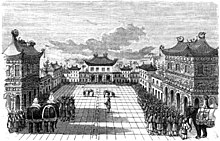
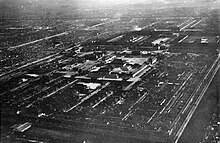
When the Hongwu Emperor's son Zhu Di became the Yongle Emperor, he moved the capital from Nanjing to Beijing, and construction began in 1406 on what would become the Forbidden City.
Construction lasted 14 years and required more than a million workers. Material used include whole logs of precious Phoebe zhennan wood (楠木; nánmù) found in the jungles of south-western China, and large blocks of marble from quarries near Beijing. The floors of major halls were paved with "golden bricks" (金磚; jīnzhuān), specially baked paving bricks from Suzhou.
From 1420 to 1644, the Forbidden City was the seat of the Ming dynasty. In April 1644, it was captured by rebel forces led by Li Zicheng, who proclaimed himself emperor of the Shun dynasty. He soon fled before the combined armies of former Ming general Wu Sangui and Manchu forces, setting fire to parts of the Forbidden City in the process.
By October, the Manchus had achieved supremacy in northern China, and a ceremony was held at the Forbidden City to proclaim the young Shunzhi Emperor as ruler of all China under the Qing dynasty. The Qing rulers changed the names on some of the principal buildings to emphasise "harmony" rather than "supremacy", made the nameplates bilingual (Chinese and Manchu), and introduced shamanist elements to the palace.
In 1860, during the Second Opium War, Anglo-French forces took control of the Forbidden City and occupied it until the end of the war. In 1900 Empress Dowager Cixi fled from the Forbidden City during the Boxer Rebellion, leaving it to be occupied by forces of the treaty powers until the following year.
After being the home of 24 emperors — 14 of the Ming dynasty and 10 of the Qing dynasty — the Forbidden City ceased being the political centre of China in 1912 with the abdication of Puyi, the last Emperor of China. Under an agreement with the new Republic of China government, Puyi remained in the Inner Court, while the Outer Court was given over to public use, until he was evicted after a coup in 1924. The Palace Museum was then established in the Forbidden City in 1925. In 1933, the Japanese invasion of China forced the evacuation of the national treasures in the Forbidden City. Part of the collection returned at the end of World War II, but the other part was evacuated to Taiwan in 1948 under orders of Chiang Kai-shek, whose Kuomintang was losing the Chinese Civil War. This relatively small but high quality collection was kept in storage until 1965, when it again became public as the core of the National Palace Museum in Taipei.
After the establishment of the People's Republic of China in 1949, some damage was done to the Forbidden City as the country was swept up in revolutionary zeal. During the Cultural Revolution, however, further destruction was prevented when Premier Zhou Enlai sent an army battalion to guard the city.
The Forbidden City was declared a World Heritage Site in 1987 by UNESCO as the "Imperial Palace of the Ming and Qing Dynasties", due to its significant place in the development of Chinese architecture and culture.
In the early 21st century, the Palace Museum carried out a sixteen-year restoration project to repair and restore all buildings in the Forbidden City to their pre-1911 state, with the goal that 76% of the palace would be open to the public by 2020. As a result of that project, the Shoukang Palace was officially opened to the public in 2013, after initially being displayed in its original state. A sculpture museum was opened in the Cining Palace in 2015. Also opened in 2015 were the precincts around Cining Palace, the Yanyin Building and the Donghua Gate.
On the 5 November 2024, 100 years was marked since the expulsion of the last Emperor of China, Puyi, from the palace by republican forces, led by Feng Yuxiang.
Structure
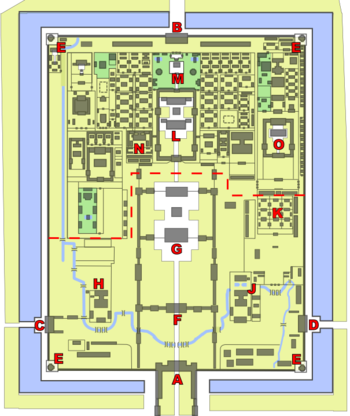
- – - Approximate dividing line between Inner (north) and Outer (south) Courts.
| A. Meridian Gate B. Gate of Divine Might C. West Glorious Gate D. East Glorious Gate E. Corner towers F. Gate of Supreme Harmony G. Hall of Supreme Harmony | H. Hall of Military Eminence J. Hall of Literary Glory K. Southern Three Places L. Palace of Heavenly Purity M. Imperial Garden N. Hall of Mental Cultivation O. Palace of Tranquil Longevity |
The Forbidden City is a rectangle, measuring 961 m (3,153 ft) from north to south and 753 m (2,470 ft) from east to west. It consists of 980 surviving buildings with 8,886 bays of rooms. A common myth states that there are 9,999 rooms including antechambers, based on oral tradition, but it is not supported by survey evidence. The layout of the Forbidden City protected the imperial code of ethics as a physical installation. The courtyard was built on a massive, luxurious scale but it has the appearance of an ordinary quadrangle courtyard. The Forbidden City was designed to be the centre of the ancient, walled city of Beijing. It is enclosed in a larger, walled area called the Imperial City. The Imperial City is, in turn, enclosed by the Inner City; to its south lies the Outer City.
The Forbidden City remains important in the civic scheme of Beijing. The central north–south axis remains the central axis of Beijing. This axis extends to the south through Tiananmen Gate to Tiananmen Square, the ceremonial centre of the People's Republic of China, and on to Yongdingmen Gate. To the north, it extends through Jingshan Park to the Drum Tower and Bell Tower. This axis is not exactly aligned north–south, but is tilted by slightly more than two degrees. Researchers now believe that the axis was designed during the Yuan dynasty to be aligned with Shangdu, the other capital of their empire.

Walls and gates
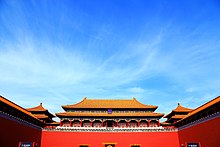


The Forbidden City is surrounded by a 7.9 m (26 ft) high city wall and a 6 m (20 ft) deep by 52 m (171 ft) wide moat. The walls are 8.62 m (28.3 ft) wide at the base, tapering to 6.66 m (21.9 ft) at the top. These walls served as both defensive walls and retaining walls for the palace. They were constructed with a rammed earth core, and surfaced with three layers of specially baked bricks on both sides, with the interstices filled with mortar.
At the four corners of the wall sit corner towers (E) with intricate roofs boasting 72 ridges, reproducing the Pavilion of Prince Teng and the Yellow Crane Pavilion as they appeared in Song dynasty paintings. These towers are the most visible parts of the palace to people outside the walls, and much folklore is attached to them. According to one legend, artisans could not put a corner tower back together after it was dismantled for renovations in the early Qing dynasty, and it was only rebuilt after the intervention of carpenter-immortal Lu Ban.
The wall is pierced by a gate on each side. At the southern end is the main Meridian Gate (A) (午門; Wǔmén). To the north is the Gate of Divine Prowess (B) (神武門; Shénwǔmén), which faces Jingshan Park. The east and west gates are the East Glorious Gate (D) (東華門; Dōnghuámén) and the West Glorious Gate (C) (西華門; Xīhuámén). All gates in the Forbidden City are decorated with nine-by-nine arrays of golden door nails, except for the East Glorious Gate, which has only eight.
The Meridian Gate has two protruding wings, which form three sides of a square before it, and five gateways. The central gateway is part of the Imperial Way, a stone flagged path that forms the central axis of the Forbidden City and the ancient city of Beijing itself, leading all the way from the Gate of China in the south to Jingshan Park in the north. Except for the empress on the occasion of her wedding and successful students after the Imperial Examination, only the emperor could walk or ride on the Imperial Way.
Outer Court or the Southern Section
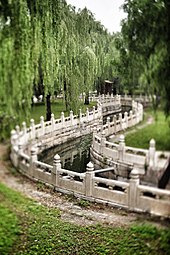




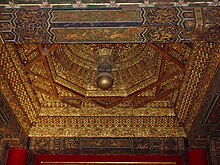


Traditionally, the Forbidden City is divided into two parts: the Outer Court (外朝; Wàicháo) or Front Court (前朝; Qiáncháo) to the south, which was used for ceremonial purposes; and the Inner Court (内廷; Nèitíng) or Back Palace (后宫; Hòugōng) to the north, which was the residence of the emperor and his family and was used for day-to-day affairs of state (the approximate dividing line shown as a red dash in the plan above). Generally, the Forbidden City has three vertical axes. The most important buildings are situated on the central north–south axis.
Entering from the Meridian Gate, one encounters a large square, pierced by the meandering Inner Golden Water River, which is crossed by five bridges. Beyond the square stands the Gate of Supreme Harmony (F) (太和門; Tàihémén). Behind that is a square from which a three-tiered white marble terrace rises and three halls stand on top of this terrace, the focus of the palace complex. From the south, these are the Hall of Supreme Harmony (太和殿; Tàihédiàn), the Hall of Central Harmony (中和殿; Zhōnghédiàn), and the Hall of Preserving Harmony (保和殿; Bǎohédiàn).
The Hall of Supreme Harmony (G) is the largest, and rises some 30 m (98 ft) above the level of the surrounding square. It is the ceremonial centre of imperial power, and the largest surviving wooden structure in China. It is nine bays wide and five bays deep, the numbers 9 and 5 being symbolically connected to the majesty of the emperor. Set into the ceiling at the centre of the hall is an intricate caisson decorated with a coiled dragon, from the mouth of which issues a chandelier-like set of metal balls, called the "Xuanyuan Mirror". In the Ming dynasty, the emperor held court here to discuss affairs of state. During the Qing dynasty, as emperors held court far more frequently, a less ceremonious location was used instead, and the Hall of Supreme Harmony was only used for ceremonial purposes, such as enthronements, investitures, and imperial weddings.
The Hall of Central Harmony is a smaller, square hall, used by the emperor to prepare and rest before and during ceremonies. Behind it, the Hall of Preserving Harmony, was used for rehearsing ceremonies, and was also the site of the final stage of the Imperial Examination. All three halls feature imperial thrones, the largest and most elaborate one being that in the Hall of Supreme Harmony.
At the centre of the stairs leading up to the terraces from the northern and southern sides are ceremonial ramps, part of the Imperial Way, featuring elaborate and symbolic bas-relief carvings. The northern ramp, behind the Hall of Preserving Harmony, is carved from a single piece of stone 16.57 m (54.4 ft) long, 3.07 m (10.1 ft) wide, and 1.7 m (5.6 ft) thick. It weighs some 200 tons and is the largest such carving in China. The southern ramp, in front of the Hall of Supreme Harmony, is even longer, but is made from two stone slabs joined — the joint was ingeniously hidden using overlapping bas-relief carvings, and was only discovered when weathering widened the gap in the 20th century. The stone slabs were likely transported from a quarry via ice sledge along an ice path lubricated by well water en route.
In the southwest and southeast of the Outer Court are the halls of Military Eminence (H) and Literary Glory (J). The former was used at various times for the emperor to receive ministers and hold court, and later housed the palace's own printing house. The latter was used for ceremonial lectures by highly regarded Confucian scholars, and later became the office of the Grand Secretariat. A copy of the Complete Library of the Four Treasuries was stored there. To the north-east are the Southern Three Places (南三所) (K), which was the residence of the crown prince.
Inner Court or the Northern Section
The Inner Court is separated from the Outer Court by an oblong courtyard lying orthogonal to the city's main axis. It was the home of the Emperor and his family. In the Qing dynasty, the Emperor lived and worked almost exclusively in the Inner Court, with the Outer Court used only for ceremonial purposes.
Back Three Palaces
At the centre of the Inner Court is another set of three halls (L). From the south, these are:
Smaller than the Outer Court halls, the three halls of the Inner Court were the official residences of the Emperor and the Empress. The Emperor, representing Yang and the Heavens, would occupy the Palace of Heavenly Purity. The Empress, representing Yin and the Earth, would occupy the Palace of Earthly Tranquility. In between them was the Hall of Union, where the Yin and Yang mixed to produce harmony.



The Palace of Heavenly Purity is a double-eaved building, and set on a single-level white marble platform. It is connected to the Gate of Heavenly Purity to its south by a raised walkway. In the Ming dynasty, it was the residence of the Emperor. However, beginning from the Yongzheng Emperor of the Qing dynasty, the Emperor lived instead at the smaller Hall of Mental Cultivation (N) to the west, out of respect to the memory of the Kangxi Emperor. The Palace of Heavenly Purity then became the Emperor's audience hall. A caisson is set into the roof, featuring a coiled dragon. Above the throne hangs a tablet reading "Justice and Honour" (Chinese: 明光大正; pinyin: míngguāng dà zhèng).
The Palace of Earthly Tranquility (坤寧宮) is a double-eaved building, 9 bays wide and 3 bays deep. In the Ming dynasty, it was the residence of the Empress. In the Qing dynasty, large portions of the Palace were converted for Shamanist worship by the new Manchu rulers. From the reign of the Yongzheng Emperor, the Empress moved out of the Palace. However, two rooms in the Palace of Earthly Harmony were retained for use on the Emperor's wedding night.
Between these two palaces is the Hall of Union, which is square in shape with a pyramidal roof. Stored here are the 25 Imperial Seals of the Qing dynasty, as well as other ceremonial items.
Behind these three halls lies the Imperial Garden (M). Relatively small, and compact in design, the garden nevertheless contains several elaborate landscaping features. To the north of the garden is the Gate of Divine Might.
Directly to the west is the Hall of Mental Cultivation (N). Originally a minor palace, this became the de facto residence and office of the Emperor starting from Yongzheng. In the last decades of the Qing dynasty, empresses dowager, including Cixi, held court from the eastern partition of the hall. Located around the Hall of Mental Cultivation are the offices of the Grand Council and other key government bodies.
The north-eastern section of the Inner Court is taken up by the Palace of Tranquil Longevity (寧壽宮) (O), a complex built by the Qianlong Emperor in anticipation of his retirement. It mirrors the set-up of the Forbidden City proper and features an "outer court", an "inner court", and gardens and temples. The entrance to the Palace of Tranquil Longevity is marked by a glazed-tile Nine Dragons Screen.
Six Western and Six Eastern Palaces
To the west and to the east of the three main halls of the inner court are the Six Western Palaces (西六宫; xīliùgōng) and the Six Eastern Palaces (东六宫; dōngliùgōng). These palaces were the residences of the imperial consorts. Six palaces lay to the west and six to the east of the three main halls, hence the name. The architecture of the twelve palaces, connected by passageways, is more or less the same. The Western and Eastern Palaces each have a layout of three palaces on either side of an alley that runs from north to south. Every palace has its own courtyards, main halls, and side-halls. The main halls stand in the middle and the side-halls are in the east and west. The front courtyard and its main hall was used for receptions, while the back courtyard and its main hall served as living quarters.
An imperial consort with the rank of concubine and above was given a residence in the main section of a palace and was the manager of that palace, an honor in itself. Lower ranking imperial consorts (noble ladies and below) lived in the side halls of the palaces and were supervised by the higher ranking imperial consort.
The twelve palaces were the place where many of the Qing emperors were born and grew up, and they formed the daily life of the imperial family.
During the late Qing era, Empress Dowager Cixi resided in one of the Western Palaces and became known as the "western empress", while her co-regent Empress Dowager Ci'an lived in one of the Eastern Palaces and was thus known as the "eastern empress".
The names of the palaces were:
Western Six Palaces
- Palace of Eternal Longevity (永寿宫; Yǒngshòugōng)
- Hall of the Supreme Principle (太极殿; Tàijídiàn)
- Palace of Eternal Spring (长春宫; Chǎngchūngōng)
- Palace of Earthly Honour (翊坤宫; Yìkūngōng)
- Palace of Gathering Elegance [ko; vi; zh] (储秀宫; Chǔxiùgōng)
- Palace of Universal Happiness (咸福宫; Xíanfúgōng)
Eastern Six Palaces
- Palace of Great Benevolence [vi; zh] (景仁宫; Jǐngréngōng)
- Palace of Heavenly Grace (承乾宫; Chéngqiángōng)
- Palace of Accumulated Purity [vi; zh] (锺粹宫; Zhōngcuìgōng)
- Palace of Prolonging Happiness (延禧宫; Yánxǐgōng)
- Palace of Great Brilliance [ko; vi; zh] (景阳宫; Jǐngyánggōng)
- Palace of Eternal Harmony [vi; zh] (永和宫; Yǒnghégōng)
Cining Palace and Shoukang Palace
To the west of the Hall of Mental Cultivation (N) in the western area of the Inner Court is Cining Palace (Palace of Compassion and Tranquility) and Shoukang Palace (Palace of Longevity and Good Health). The palaces were the residences of widowed consorts of previous emperors. In accordance with feudal manners, emperors should not live with the wives of late emperors, so they lived in this separate area of the Inner Court. The Cining palace is bigger and older than Shoukang Palace which is located to the west of Cining Palace. To the south of Cining Palace is Cining garden.
Religion

Religion was an important part of life for the imperial court. In the Qing dynasty, the Palace of Earthly Harmony became a place of Manchu Shamanist ceremony. At the same time, the native Chinese Taoist religion continued to have an important role throughout the Ming and Qing dynasties. There were two Taoist shrines, one in the imperial garden and another in the central area of the Inner Court.
Another prevalent form of religion in the Qing dynasty palace was Buddhism. A number of temples and shrines were scattered throughout the Inner Court, including that of Tibetan Buddhism or Lamaism. Buddhist iconography also proliferated in the interior decorations of many buildings. Of these, the Pavilion of the Rain of Flowers is one of the most important. It housed a large number of Buddhist statues, icons, and mandalas, placed in ritualistic arrangements.
Surroundings
See also: Imperial City (Beijing)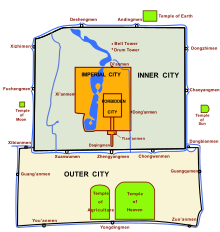
The palace complex is surrounded by numerous opulent imperial gardens and temples including the 22 ha (54-acre) Zhongshan Park, the sacrificial Imperial Ancestral Temple, the 69 ha (171-acre) Beihai Park, and the 23 ha (57-acre) Jingshan Park.
The Forbidden City is surrounded on three sides by imperial gardens. To the north is Jingshan Park, also known as Prospect Hill, an artificial hill created from the soil excavated to build the moat and from nearby lakes.
To the west lies Zhongnanhai, a former royal garden centred on two connected lakes, which now serves as the central headquarters for the Chinese Communist Party and the State Council of the People's Republic of China. To the north-west lies Beihai Park, also centred on a lake connected to the southern two, and a popular royal park.
To the south of the Forbidden City were two important shrines – the Imperial Shrine of Family or the Imperial Ancestral Temple (Chinese: 太廟; pinyin: Tàimiào) and the Imperial Shrine of State or Beijing Shejitan (Chinese: 社稷壇; pinyin: Shèjìtán), where the Emperor would venerate the spirits of his ancestors and the spirit of the nation, respectively. Today, these are the Beijing Labouring People's Cultural Hall and Zhongshan Park (commemorating Sun Yat-sen) respectively.
To the south, two nearly identical gatehouses stand along the main axis. They are the Upright Gate (Chinese: 端门; pinyin: Duānmén) and the more famous Tiananmen Gate, which is decorated with a portrait of Mao Zedong in the centre and two placards to the left and right: "Long Live the People's Republic of China" (Chinese: 中华人民共和国万岁; pinyin: zhōnghuá rénmín gònghéguó wànsuì) and "Long live the Great Unity of the World's Peoples" (Chinese: 世界人民大团结万岁; pinyin: shìjiè rénmín dàtuánjié wànsuì). The Tiananmen Gate connects the Forbidden City precinct with the modern, symbolic centre of the Chinese state, Tiananmen Square.
While development is now tightly controlled in the vicinity of the Forbidden City, throughout the past century uncontrolled and sometimes politically motivated demolition and reconstruction has changed the character of the areas surrounding the Forbidden City. Since 2000, the Beijing municipal government has worked to evict governmental and military institutions occupying some historical buildings, and has established a park around the remaining parts of the Imperial City wall. In 2004, an ordinance relating to building height and planning restriction was renewed to establish the Imperial City area and the northern city area as a buffer zone for the Forbidden City. In 2005, the Imperial City and Beihai (as an extension item to the Summer Palace) were included in the shortlist for the next World Heritage Site in Beijing.
Architecture
Symbolism
 Imperial Palace color of the highest status on the roof ridge of the Hall of Supreme Harmony
Imperial Palace color of the highest status on the roof ridge of the Hall of Supreme Harmony
The design of the Forbidden City, from its overall layout to the smallest detail, was meticulously planned to reflect philosophical and religious principles, and above all to symbolize the majesty of Imperial power. Some noted examples of symbolic designs include:
- Yellow is the color of the Emperor. Thus almost all roofs in the Forbidden City bear yellow glazed tiles. There are only two exceptions. The library at the Pavilion of Literary Profundity (文渊阁) had black tiles because black was associated with water, and thus fire-prevention. Similarly, the Crown Prince's residences have green tiles because green was associated with wood, and thus growth.
- The main halls of the Outer and Inner courts are all arranged in groups of three – the shape of the Qian trigram ☰, representing Heaven. The residences of the Inner Court on the other hand are arranged in clusters of six – the shape of the Kun trigram ☷, representing the Earth.
- The sloping ridges of building roofs are decorated with a line of statuettes led by a man riding a phoenix and followed by an imperial dragon. The number of statuettes represents the status of the building – a minor building might have three or five. The Hall of Supreme Harmony has ten, the only building in the country to be permitted this in Imperial times. As a result, its tenth statuette, called a "Hangshi", or "ranked tenth" (Chinese: 行十; pinyin: Hángshí), is also unique in the Forbidden City.
- The layout of buildings follows ancient customs laid down in the Classic of Rites. Thus, ancestral temples are in front of the palace. Storage areas are placed in the front part of the palace complex, and residences in the back.
Collections
Main article: Palace Museum



The collections of the Palace Museum are based on the Qing imperial collection, including paintings, ceramics, seals, steles, sculptures, inscribed wares, bronze wares and enamel objects. According to the latest audit, it has 1,862,690 pieces of art. In addition, the imperial libraries housed a large collection of rare books and historical documents, including government documents of the Ming and Qing dynasties, which has since been transferred to the First Historical Archives.
From 1933, the threat of Japanese invasion forced the evacuation of the most important parts of the Museum's collection. After the end of World War II, this collection was returned to Nanjing. However, with the Communists' victory imminent in the Chinese Civil War, the Nationalist government decided to ship the pick of this collection to Taiwan. Of the 13,491 boxes of evacuated artefacts, 2,972 boxes are now housed in the National Palace Museum in Taipei. More than 8,000 boxes were returned to Beijing, but 2,221 boxes remain today in storage under the charge of the Nanjing Museum.
The Palace Museum holds 340,000 pieces of ceramics and porcelain. These include imperial collections from the Tang dynasty and the Song dynasty. It has close to 50,000 paintings, within which more than 400 date from before the Yuan dynasty (1271–1368), which is the largest in China. Its bronze collection dates from the early Shang dynasty. Of the almost 10,000 pieces held, about 1,600 are inscribed items from the pre-Qin period (to 221 BC). A significant part of the collection is ceremonial bronzeware from the imperial court. The Palace Museum has one of the largest collections of mechanical timepieces of the 18th and 19th centuries in the world, with more than 1,000 pieces. The collection contains both Chinese- and foreign-made pieces. Chinese pieces came from the palace's own workshops. Foreign pieces came from countries including Britain, France, Switzerland, the United States, and Japan. Of these, the largest portion come from Britain.Jade has a unique place in Chinese culture. The Museum's collection includes some 30,000 pieces. The pre-Yuan dynasty part of the collection includes several pieces famed throughout history. The earliest pieces date from the Neolithic period. In addition to works of art, a large proportion of the Museum's collection consists of the artifacts of the imperial court. This includes items used by the imperial family and the palace in daily life. This comprehensive collection preserves the daily life and ceremonial protocols of the imperial era.
Influence


The Forbidden City has been influential in the subsequent development of Chinese architecture, as well as in providing inspiration for many artistic works.
Depiction in art, film, literature and popular culture
The Forbidden City has served as the scene to many works of fiction. In recent years, it has been depicted in films and television series. Some notable examples include:
- The Forbidden City (1918), a fiction film about a Chinese emperor and an American.
- The Last Emperor (1987), a biographical film about Puyi, was the first feature film ever authorised by the government of the People's Republic of China to be filmed in the Forbidden City.
- Forbidden City Cop (1996), a Hong Kong wuxia comedy film about an imperial secret agent.
- Marco Polo (1982), a joint NBC and RAI miniseries filmed inside the Forbidden City. Note, however, that the present Forbidden City did not exist during the Mongol-led Yuan dynasty, when Marco Polo met Kublai Khan.
- The 2003 real-time strategy game Rise of Nations depicts the Forbidden City as one of the great wonders of the world; in terms of game mechanics, it functions identically to a major city and provides additional resources to the player.
- The Forbidden City is a buildable Wonder in many different titles of the Civilization series of video games.
See also
References
- 故宫2017年接待观众逾1699万人次 创历史新纪录 (in Chinese). 31 December 2017. Archived from the original on 25 March 2018. Retrieved 24 March 2018.
- ^ "UNESCO World Heritage List: Imperial Palaces of the Ming and Qing Dynasties in Beijing and Shenyang". UNESCO. Archived from the original on 5 May 2007. Retrieved 4 May 2007.
- ^ "Amazing Facts About the Forbidden City". Oakland Museum of California. Archived from the original on 14 June 2012.
- ^ Lu, Yongxiang (2014). A History of Chinese Science and Technology, Volume 3. New York: Springer. ISBN 978-3-662-44163-3.
- ^ "Advisory Body Evaluation (1987)" (PDF). UNESCO. Archived (PDF) from the original on 2 November 2015. Retrieved 25 February 2016.
- "1900万!故宫年客流量创新高-新华网". www.xinhuanet.com. Archived from the original on 6 December 2020. Retrieved 21 January 2020.
- "How much the world's most valuable palaces are worth". MSN.com. Archived from the original on 10 January 2021. Retrieved 10 December 2020.
Forbidden City, China – $69.66 billion+ (£54bn+). The crown jewel of Beijing, the Forbidden City was the residence of the Chinese emperors and the locus of government from 1420 to 1912. Now a museum, the complex was declared a UNESCO World Heritage Site in 1987.
- Centre, UNESCO World Heritage. "Imperial Palaces of the Ming and Qing Dynasties in Beijing and Shenyang". UNESCO World Heritage Centre. Archived from the original on 2 December 2021. Retrieved 1 December 2021.
- p26, Barmé, Geremie R (2008). The Forbidden City. Harvard University Press.
- See, e.g., Gan, Guo-hui (April 1990). "Perspective of urban land use in Beijing". GeoJournal. 20 (4): 359–364. doi:10.1007/bf00174975. S2CID 154980396.
- "Gùgōng" in a generic sense also refers to all former palaces, another prominent example being the former Imperial Palaces (Mukden Palace) in Shenyang; see Gugong (disambiguation).
- p. 18, Yu, Zhuoyun (1984). Palaces of the Forbidden City. New York: Viking. ISBN 0-670-53721-7.
- ^ p. 15, Yang, Xiagui (2003). The Invisible Palace. Li, Shaobai (photography); Chen, Huang (translation). Beijing: Foreign Language Press. ISBN 7-119-03432-4.
- China Central Television, The Palace Museum (2005). Gugong: "I. Building the Forbidden City" (Documentary). China: CCTV. Archived from the original on 31 July 2020. Retrieved 22 July 2018.
- p. 69, Yang (2003)
- p. 3734, Wu, Han (1980). 朝鲜李朝实录中的中国史料 (Chinese historical material in the Annals of the Joseon Yi dynasty). Beijing: Zhonghua Book Company. CN / D829.312.
- Guo, Muoruo (20 March 1944). "甲申三百年祭 (Commemorating 300th anniversary of the Jia-Sheng Year)". New China Daily (in Chinese).
- ^ China Central Television, The Palace Museum (2005). Gugong: "II. Ridgeline of a Prosperous Age" (Documentary). China: CCTV. Archived from the original on 31 July 2020. Retrieved 22 July 2018.
- "故宫外朝宫殿为何无满文? (Why is there no Manchu on the halls of the Outer Court?)". People Net (in Chinese). 16 June 2006. Archived from the original on 1 December 2008. Retrieved 12 July 2007.
- Zhou Suqin. "坤宁宫 (Palace of Earthly Tranquility)" (in Chinese). The Palace Museum. Archived from the original on 29 September 2007. Retrieved 12 July 2007.
- ^ China Central Television, The Palace Museum (2005). Gugong: "XI. Flight of the National Treasures" (Documentary). China: CCTV. Archived from the original on 31 July 2020. Retrieved 22 July 2018.
- p. 137, Yang (2003)
- Yan, Chongnian (2004). "国民—战犯—公民 (National – War criminal – Citizen)". 正说清朝十二帝 (True Stories of the Twelve Qing Emperors) (in Chinese). Beijing: Zhonghua Book Company. ISBN 7-101-04445-X.
- Cao Kun (6 October 2005). "故宫X档案: 开院门票 掏五毛钱可劲逛 (Forbidden City X-Files: Opening admission 50 cents)". Beijing Legal Evening (in Chinese). People Net. Archived from the original on 1 December 2008. Retrieved 25 July 2007.
- See map of the evacuation routes at: "National Palace Museum – Tradition & Continuity". National Palace Museum. Archived from the original on 20 March 2007. Retrieved 1 May 2007.
- "National Palace Museum – Tradition & Continuity". National Palace Museum. Archived from the original on 20 March 2007. Retrieved 1 May 2007.
- ^ "三大院长南京说文物 (Three museum directors talk artefacts in Nanjing)". Jiangnan Times (in Chinese). People Net. 19 October 2003. Archived from the original on 1 December 2008. Retrieved 5 July 2007.
- Chen, Jie (4 February 2006). "故宫曾有多种可怕改造方案 (Several horrifying reconstruction proposals had been made for the Forbidden City)". Yangcheng Evening News (in Chinese). Eastday. Archived from the original on 27 May 2019. Retrieved 1 May 2007.
- Xie, Yinming; Qu, Wanlin (7 November 2006). ""文化大革命"中谁保护了故宫 (Who protected the Forbidden City in the Cultural Revolution?)". CPC Documents (in Chinese). People Net. Archived from the original on 2 April 2019. Retrieved 25 July 2007.
- The Forbidden City was listed as the "Imperial Palace of the Ming and Qing Dynasties Archived 26 March 2009 at the Wayback Machine" (Official Document). In 2004, Mukden Palace in Shenyang was added as an extension item to the property, which then became known as "Imperial Palaces of the Ming and Qing Dynasties in Beijing and Shenyang": "UNESCO World Heritage List: Imperial Palaces of the Ming and Qing Dynasties in Beijing and Shenyang". Archived from the original on 5 May 2007. Retrieved 4 May 2007.
- Palace Museum. "Forbidden City restoration project website". Archived from the original on 21 April 2007. Retrieved 3 May 2007.
- "故宫慈宁宫花园明年8月开放 拟推年票定价300元". People's Daily. 18 August 2014. Archived from the original on 2 October 2022. Retrieved 1 May 2021.
- As larger buildings in traditional Chinese architecture are easily and regularly sub-divided into different configurations, the number of rooms in the Forbidden City is traditionally counted in terms of "bays" of rooms, with each bay being the space defined by four structural pillars.
- Glueck, Grace (31 August 2001). "ART REVIEW; They Had Expensive Tastes". The New York Times. Archived from the original on 21 October 2020. Retrieved 19 February 2017.
- "Numbers Inside the Forbidden City". China Daily. China.org.cn. 20 July 2007. Archived from the original on 22 July 2018. Retrieved 22 July 2018.
- Liu, Peng; Lan, Lan (July 2021). "Bodily Changes: Castration as Cultural and Social Practice in the Space of the Forbidden City". SAGE Open. 11 (3): 215824402110407. doi:10.1177/21582440211040772. ISSN 2158-2440. S2CID 238145832.
- 北京确立城市发展脉络 重塑7.8公里中轴线 [Beijing to establish civic development network; Recreating 7.8 km (4.8 mi) central axis] (in Chinese). People Net. 30 May 2006. Archived from the original on 19 October 2020. Retrieved 5 July 2007.
- Pan, Feng (2 March 2005). 探秘北京中轴线 [Exploring the mystery of Beijing's Central Axis]. Science Times (in Chinese). Chinese Academy of Sciences. Archived from the original on 11 December 2007. Retrieved 19 October 2007.
- p. 25, Yang (2003)
- ^ p. 32, Yu (1984)
- Technically, Tiananmen Gate is not part of the Forbidden City; it is a gate of the Imperial City.
- ^ p. 25, Yu (1984)
- p. 33, Yu (1984)
- ^ p. 49, Yu (1984)
- p. 48, Yu (1984)
- ^ The Palace Museum. "Yin, Yang and the Five Elements in the Forbidden City" (in Chinese). Archived from the original on 1 July 2007. Retrieved 5 July 2007.
- p. 253, Yu (1984)
- The Palace Museum. "太和殿 (Hall of Supreme Harmony)" (in Chinese). Archived from the original on 17 June 2007. Retrieved 25 July 2007.
- The Palace Museum. "中和殿 (Hall of Central Harmony)" (in Chinese). Archived from the original on 30 May 2007. Retrieved 25 July 2007.
- The Palace Museum. "保和殿 (Hall of Preserving Harmony)" (in Chinese). Archived from the original on 30 September 2007. Retrieved 25 July 2007.
- p. 70, Yu (1984)
- For an explanation and illustration of the joint, see p. 213, Yu (1984)
- Nickell, Joe (May–June 2020). "Secrets of Beijing's Forbidden City". Skeptical Inquirer. Vol. 44, no. 3. Amherst, New York: Center for Inquiry.
- p. 73, Yu (1984)
- p. 75, Yu (1984)
- p. 78, Yu (1984)
- p. 51, Yang (2003)
- pp. 80–83, Yu (1984)
- ^ China Central Television, The Palace Museum (2005). Gugong: "III. Rites under Heaven " (Documentary). China: CCTV. Archived from the original on 31 July 2020. Retrieved 22 July 2018.
- p. 121, Yu (1984)
- p. 87, Yu (1984)
- p. 115, Yu (1984)
- "Six Western Palaces, Xiliugong - Forbidden City, Beijing". www.travelchinaguide.com. Archived from the original on 10 January 2021. Retrieved 20 April 2019.
- "Six Eastern Palaces, Dongliugong - Forbidden City, Beijing". www.travelchinaguide.com. Archived from the original on 10 January 2021. Retrieved 9 May 2020.
- "Palace of Compassion and Tranquility - Forbidden City". www.travelchinaguide.com. Archived from the original on 10 January 2021. Retrieved 9 May 2020.
- p. 176, Yu (1984)
- p. 177, Yu (1984)
- pp. 189–193, Yu (1984)
- Gao, Jie. "Symbolism in the Forbidden City: The Magnificent Design, Distinct Colors, and Lucky Numbers of China's Imperial Palace". Association for Asian Studies. Archived from the original on 18 November 2021. Retrieved 18 November 2021.
- p. 20, Yu (1984)
- "Working People's Cultural Palace". China.org.cn. Archived from the original on 11 October 2007. Retrieved 29 July 2007.
- "Zhongshan Park". China.org.cn. Archived from the original on 19 August 2007. Retrieved 29 July 2007.
- "Forbidden City Buffer Zone Plan submitted to World Heritage conference" (in Chinese). Xinhua Net. 16 July 2005. Archived from the original on 7 December 2008. Retrieved 13 April 2007.
- Li, Yang (4 June 2005). "Beijing confirms 7 World Heritage alternate items; Large scale reconstruction of Imperial City halted" (in Chinese). Xinhua Net. Archived from the original on 6 February 2007. Retrieved 13 April 2007.
- The Palace Museum. "Hall of Supreme Harmony" (in Chinese). Archived from the original on 1 July 2007. Retrieved 5 July 2007.
- "祠堂与祠堂文化 _世界王氏网". www.wwdoa.com. Archived from the original on 18 August 2020. Retrieved 25 September 2022.
- Steinhardt, Nancy Shatzman (December 1986). "Why were Chang'an and Beijing so different?". The Journal of the Society of Architectural Historians. 45 (4): 339–357. doi:10.2307/990206. JSTOR 990206.
- Dorn, Frank (1970). The forbidden city: the biography of a palace. New York: Charles Scribner's Sons. p. 176. OCLC 101030.
- The Palace Museum. "Collection highlights – Paintings" (in Chinese). Archived from the original on 1 July 2007. Retrieved 5 July 2007.
- The Palace Museum. "Collection highlights – Bronzeware" (in Chinese). Archived from the original on 1 July 2007. Retrieved 5 July 2007.
- The Palace Museum. "Collection highlights – Timepieces" (in Chinese). Archived from the original on 1 July 2007. Retrieved 5 July 2007.
- Laufer, Berthold (1912). Jade: A Study in Chinese Archeology & Religion. Gloucestor MA: Reprint (1989): Peter Smith Pub Inc. ISBN 978-0-8446-5214-6.
- The Palace Museum. "Collection highlights – Jade" (in Chinese). Archived from the original on 1 July 2007. Retrieved 5 July 2007.
- The Palace Museum. "Collection highlights – Palace artefacts" (in Chinese). Archived from the original on 1 July 2007. Retrieved 5 July 2007.
Further reading
- Aisin-Gioro, Puyi (1964). From Emperor to citizen : the autobiography of Aisin-Gioro Pu Yi. Beijing: Foreign Language Press. ISBN 0-19-282099-0.
- Huang, Ray (1981). 1587, A Year of No Significance: The Ming Dynasty in Decline. New Haven: Yale University Press. ISBN 0-300-02518-1.
- Yang, Xiagui (2003). The Invisible Palace. Li, Shaobai (photography); Chen, Huang (translation). Beijing: Foreign Language Press. ISBN 7-119-03432-4.
- Yu, Zhuoyun (1984). Palaces of the Forbidden City. New York: Viking. ISBN 0-670-53721-7.
- Barmé, Geremie R (2008). The Forbidden City. Harvard University Press. 251 pages. ISBN 978-0-674-02779-4.
- Cotterell, Arthur (2007). The Imperial Capitals of China – An Inside View of the Celestial Empire. London: Pimlico. 304 pages. ISBN 978-1-84595-009-5.
- Ho; Bronson (2004). Splendors of China's Forbidden City. London: Merrell Publishers. ISBN 1-85894-258-6.
External links
- Palace Museum official site (Digital Palace Museum)
- Satellite photograph of the Forbidden City
- UNESCO World Heritage Centre – panographies (360 degree imaging) (archived 5 May 2008)
- Nova: Secrets of the Forbidden City
 Geographic data related to Forbidden City at OpenStreetMap
Geographic data related to Forbidden City at OpenStreetMap
| Palace Museum | |||||||||||||||||||||||
|---|---|---|---|---|---|---|---|---|---|---|---|---|---|---|---|---|---|---|---|---|---|---|---|
| Forbidden City · History of the Forbidden City | |||||||||||||||||||||||
| |||||||||||||||||||||||
| World Heritage Sites in China | ||
|---|---|---|
| East |
|  |
| South Central |
| |
| Southwestern | ||
| North | ||
| Northeast | ||
| Northwestern | ||
| Multiple regions |
| |
| Qing dynasty topics | |||||||||
|---|---|---|---|---|---|---|---|---|---|
| History |
| ||||||||
| Government |
| ||||||||
| Military | |||||||||
| Special regions | |||||||||
| Palaces & mausoleums | |||||||||
| Society & culture |
| ||||||||
| Treaties |
| ||||||||
| Currency |
| ||||||||
| Other topics |
| ||||||||
- Forbidden City
- AAAAA-rated tourist attractions
- Buildings and structures completed in 1420
- Buildings and structures in Dongcheng District, Beijing
- Major National Historical and Cultural Sites in Beijing
- Ming dynasty architecture
- Palaces in China
- Royal residences in China
- World Heritage Sites in China
- Museums in Beijing
- 1406 establishments
- 1420 establishments in Asia
- 15th-century establishments in China

